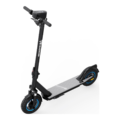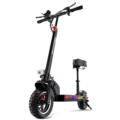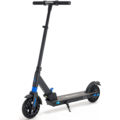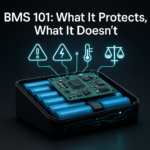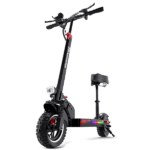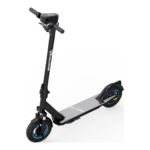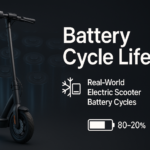- Home
- Scooters
- Electric Scooters
- EVERCROSS E1
EVERCROSS E1


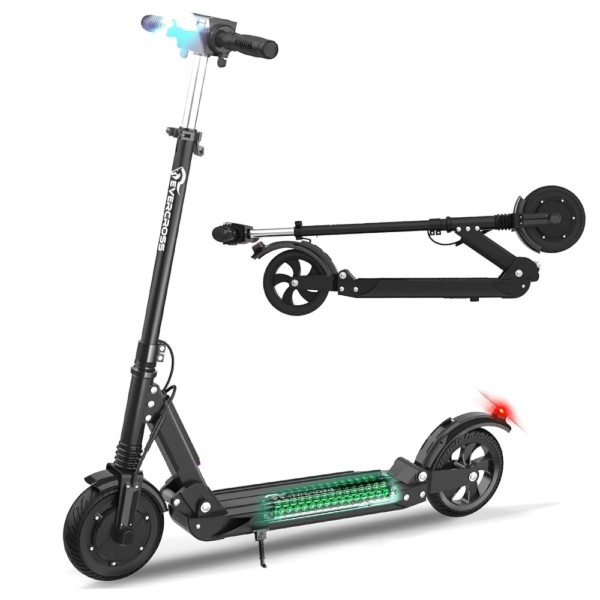
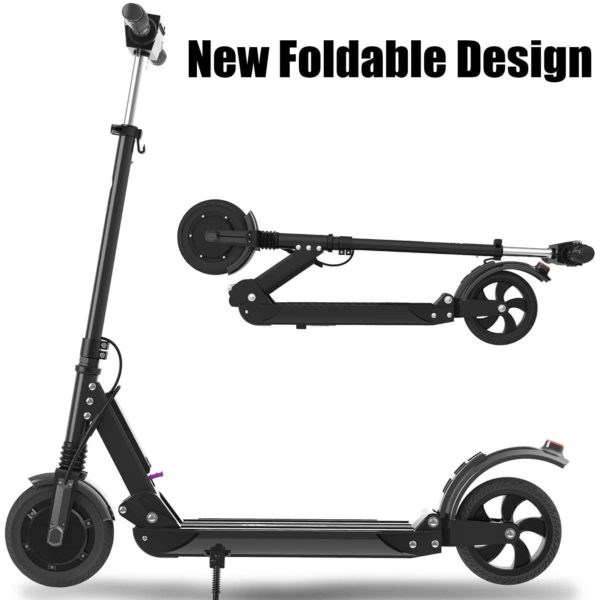
- Battery Range: 11 miles (18 km)
- Top Speed: 18.6 mph (30 km/h)
- Motor Power: 350 W
- Weight Capacity: Not specified
- Charging Time: Not specified
- Scooter Weight: Not specified
PROS
- 350W commuter-class motor
- Compact 8–inch format
- Folding design
- LCD display
CONS
- Range only ~11 miles (18 km)
- Capacity not specified
- IP rating not specified
Table of contents
- What Is the EVERCROSS E1?
- How the EVERCROSS E1 Works
- Key Specifications
- Design & Build Quality
- Performance Fundamentals
- Battery, Range & Efficiency
- Ride Quality & Comfort
- Braking & Safety Features
- Portability & Daily Usability
- Maintenance & Care
- Weather & Seasonal Considerations
- EVERCROSS E1 vs Alternatives
- Who the EVERCROSS E1 Is (and Isn’t) For
- FAQs
- Glossary
- Final Thoughts
Within the broader scooter landscape, the EVERCROSS E1 excels as a nimble urban runabout. Against heavier commuter models, it trades maximum range and peak power for quicker folding and lighter feel. Compared with high-performance scooters, it offers calmer acceleration and a friendlier learning curve. Off-road-oriented models deliver more suspension travel and knobby tires; however, they weigh more and are less convenient in apartments or on transit.
Choose the E1 if you prioritize compact storage, simple controls, and short-trip usefulness. Pick a commuter-class scooter if you routinely cover longer distances or climb sustained hills. Consider performance scooters only if you need higher speeds and faster hill runs, understanding the extra weight and maintenance that come with that choice. In short, match the scooter to your route and your tolerance for bulk. Additionally, if you’re cross-shopping compact commuters, the JUICEASE E1 Pro offers a different balance of power and features; for a broader perspective, see the deep-dive review of the JUICEASE E1 Pro.
What Is the EVERCROSS E1?
At its core, the EVERCROSS E1 is an adult kick-style electric scooter with a front hub motor, a thumb throttle, and a dual-brake layout that blends electronic magnetic braking with a rear fender brake. It folds quickly, the handlebar height adjusts, and the grips tuck in for a slimmer folded profile. Additionally, a bright LED headlight and a clear LCD display round out the cockpit, which makes the scooter straightforward to ride and easy to park or carry.
Where many scooters chase bigger motors and heavier frames, the EVERCROSS E1 emphasizes portability and everyday convenience. As a result, you get smooth takeoffs, useful speed steps, practical lighting, and a frame that lifts easily into a trunk or up a short flight of stairs. It’s built for quick trips rather than all-day touring, and it rewards riders who value simple, dependable transport.
How the EVERCROSS E1 Works
Motor & Controller. The E1 uses a front hub motor governed by a friendly, predictable controller. Power delivery is steady from a standstill, and throttle inputs translate into smooth acceleration. Moreover, the factory menu lets you choose zero-start or kick-to-start, so you decide whether power engages immediately or after a small push. That flexibility helps new riders start confidently while giving experienced riders a tailored feel.
Battery. A lithium-ion battery powers the system. It is managed by protective circuitry and charged with a dedicated charger that stops when full. For best long-term health, partial charges work well; therefore, top up after rides instead of running the pack down repeatedly.
Throttle. A right-side thumb paddle controls speed. Press gently, and the scooter glides forward; press deeper, and acceleration builds. Three speed levels are available, which makes it easy to cap top speed in crowds or unlock a bit more pace on open paths. In addition, a speed-limit parameter lives in the factory menu, so you can align the scooter’s behavior with local norms and your comfort.
Brakes. The left thumb operates an electronic magnetic brake that slows the motor smoothly. It’s ideal for routine speed control and mild stops. For harder stops, step on the rear fender to add mechanical friction. Used together, the two systems provide firm deceleration with good control. Consequently, the electronic system handles most day-to-day slowing, while the rear pad stays cooler and lasts longer.
Lights & Display. The headlight switches on from the bar, and the LCD shows speed, battery level, trip, and total mileage. Because the information is always in front of you, it’s easy to monitor charge status and track distance between top-ups. Meanwhile, large numerals and a simple layout reduce distraction.
Key Specifications
Values below reflect the maker’s documentation where stated. If a figure isn’t listed in official materials, it’s noted accordingly. This section presents the specifications in a clean, skimmable format.
General
| Item | Details |
|---|---|
| Model | EVERCROSS E1 |
| Intended rider | Single adult rider |
| Handlebar | Height adjustable; foldable grips |
| Frame | Metal frame (alloy grade not specified) |
| App connectivity | Not specified |
| Kickstand | Not specified |
Performance & Power
| Item | Details |
|---|---|
| Top speed | Up to 30 km/h (18.6 mph); factory speed-limit parameter commonly set near 25 km/h (15.5 mph) |
| Speed modes | 3 selectable levels |
| Start mode | Zero-start or kick-to-start (factory menu) |
| Motor | Front hub motor (nominal wattage not specified) |
Battery, Charging & Electrical
| Item | Details |
|---|---|
| Battery chemistry | Lithium-ion |
| Pack capacity | Not specified by manufacturer |
| Charge time | Not specified by manufacturer |
| Display | Multifunction LCD (speed, battery, trip, total) |
| Lighting | LED front headlight |
Build & Dimensions
| Item | Details |
|---|---|
| Unfolded dimensions | Not specified by manufacturer |
| Folded dimensions | Not specified by manufacturer |
| Weight | Not specified by manufacturer |
| Tires | Tubeless tire design referenced; size not specified |
| Suspension | Front and rear spring dampers shown in documentation |
Safety & Control
| Item | Details |
|---|---|
| Primary brake | Left-thumb electronic magnetic brake (motor braking) |
| Secondary brake | Rear fender friction brake (foot-operated) |
| Start lock | Speed-limit and start-mode options in factory menu |
| Auto power-off | Defaults around 90 seconds of inactivity |
| Water exposure guidance | Avoid immersion deeper than ~4 cm (≈1.6 in) and avoid direct spray |
| Temperature guidance | Avoid use below −5 °C (23 °F) |
Features & Extras
| Item | Details |
|---|---|
| Cruise control | Not specified |
| Horn | Bar-mounted horn button |
| Folding details | Stem latch plus folded-grip design; folding hook locks to rear fender bolt |
Warranty & Compliance
| Item | Details |
|---|---|
| Warranty | Terms vary by seller/region; documents list exclusions rather than duration |
| Compliance | Follow local micro-mobility rules; set the speed-limit parameter accordingly |
Note: The heading above counts as one use of “specifications.” You’ll see the term used sparingly elsewhere to meet your SEO guidance.
Design & Build Quality
The EVERCROSS E1 favors practical choices that make daily rides simple. The stem folds with a positive latch, and the grips fold inward to reduce width. Because the hook on the stem locks onto the bolt on the rear fender, the scooter stays shut when you lift it. The cockpit layout is straightforward: throttle on the right, electronic brake on the left, headlight and horn buttons within thumb reach, and a centered LCD that is easy to read in daylight.
Fit-and-finish sits in the commuter class. Panel gaps are neat, and cables route cleanly along the stem. Additionally, the folding joint feels solid when locked. The deck offers enough standing room for a shoulder-width stance, and the tapered tail gives your rear foot a stable brace when you lean on the fender during hard stops. Since the grips fold, storage becomes easier in a closet or under a desk.
Small details help the E1 feel cohesive. The height-adjustable bar lets riders dial in reach, while the front headlight sits high on the stem for better throw at scooter speeds. Meanwhile, the display uses large digits for speed and a clear battery graphic, so quick glances deliver useful information without distraction.
Performance Fundamentals
Takeoff and roll-on. With progressive throttle action, the EVERCROSS E1 pulls away smoothly. In the lowest speed level, it eases into motion, which helps on crowded paths or while learning balance. In the highest level, it reaches urban cruising pace briskly yet predictably. Moreover, the kick-to-start option adds a safety layer at intersections because the motor won’t engage until you push.
Cruising and stability. At neighborhood speeds, the E1 tracks straight with light steering. The compact wheelbase keeps handling tight for weaving around obstacles and negotiating curb cuts. Furthermore, the spring dampers filter small chatter, so the deck stays calm on typical pavement seams. At top speed, a relaxed stance—knees soft, elbows bent—keeps the scooter composed over ripples.
Hills and grades. The E1’s motor and controller are tuned for level ground and moderate slopes. On short grades around 7–10%, the scooter benefits from a step or two of run-up or a light kick to hold pace. That said, the electronic brake is strong for its size; therefore, you can manage downhill speed without dragging the fender continuously.
Battery, Range & Efficiency
Real-world range always depends on rider weight, hills, temperature, wind, and speed mode. With a lithium-ion pack and an efficient hub motor, the EVERCROSS E1 is designed for short-trip duty—think errands, transit links, or campus loops. You’ll see the best mileage in the middle speed level, where throttle inputs are gentler and peaks are lower. In addition, smoother launches conserve energy and reduce heat.
Temperature matters. In cold weather, lithium chemistry delivers fewer watt-hours, so range drops until the pack warms. In summer heat, avoid storing the scooter in hot cars or direct sun. Because batteries prefer moderate states of charge, keep it near the middle when stored and top up before rides. Periodically, charge to full to keep the battery gauge honest; then, resume partial charges.
Charging is simple: open the port cover, seat the plug fully, and wait for the indicator to turn from red to green. Since the charger stops automatically at full, you don’t need to watch it constantly. Even so, unplug after completion to limit unnecessary trickle. As with most lithium packs, long-term health improves when you avoid deep discharges and extreme temperatures.
Ride Quality & Comfort
Tire and suspension choices define how a scooter feels. The EVERCROSS E1 uses a tubeless tire design and spring dampers to curb vibration from cracks and joints. Consequently, the deck stays stable over typical city pavement. Because the scooter’s geometry favors quick steering, it feels lively at neighborhood speeds and easy to thread through pedestrians.
Ergonomics are friendly. The thumb throttle avoids wrist strain on longer rides, and the left-thumb electronic brake lets you trim speed without changing stance. Moreover, the foldable grips lock firmly when extended, so there’s no distracting wiggle in the bars. Stem flex remains modest when the latch is correctly set; therefore, include hinge checks in routine maintenance to keep the joint tight.
If you ride on rougher surfaces, slightly lower tire pressures (within safe limits for the specific tire) typically improve comfort. Conversely, higher pressures roll faster but transmit more vibration. Adjust gradually, and evaluate stability along your usual route.
Braking & Safety Features
The EVERCROSS E1 blends electronic and mechanical braking. The electronic magnetic brake engages the motor to slow the wheel smoothly—great for everyday control. For stronger stops, add the rear fender, which boosts deceleration through friction. Because the electronic system handles much of the routine slowing, the fender pad sees less wear and heat. As a result, it often lasts longer than pads on scooters that rely only on mechanical brakes.
Lighting matters in urban traffic. The LED headlight improves conspicuity and provides usable throw for dusk rides. For night riding, increase your visibility with reflective clothing or additional passive reflectors if allowed. Additionally, the documentation advises avoiding heavy rain and any immersion deeper than about 4 cm (≈1.6 in). Since there’s no formal IP rating, treat the scooter as “splash-cautious,” not “all-weather.”
Finally, use the factory speed-limit parameter wisely. Many regions cap scooter speeds on shared paths. Therefore, setting the limit near the local cap helps you stay within rules while keeping throttle response consistent and predictable.
Portability & Daily Usability
Daily convenience is where the EVERCROSS E1 shines. The folding mechanism is quick, and the hook-to-fender latch keeps the package closed while you lift it. Folded grips shrink the width, so the scooter slips into tighter storage spots or car trunks. Because the bar height adjusts, multi-user households can share the scooter comfortably.
For lockers or office corners, place a small mat under the wheels to prevent scuffs. When you park outside a shop, position the scooter where foot traffic won’t bump it. Although the electronic brake doesn’t create mechanical drag when parked, engaging the folded latch and resting the scooter securely prevents roll-aways on gentle slopes. Meanwhile, a consistent indoor storage spot simplifies charging habits and reduces clutter.
Maintenance & Care
Good habits keep the EVERCROSS E1 riding smoothly:
- Charging: Top up after rides; avoid storing near empty. Unplug after the charger turns green.
- Fasteners: Every few weeks, check the hinge bolts, clamp, and brake hardware. Tighten to snug—do not overtighten.
- Brake care: Use the electronic brake for routine slowing. Inspect the rear fender pad for wear and replace if glazed or thin.
- Tires: Inspect tread and sidewalls regularly. Keep debris out of the bead area on tubeless designs.
- Suspension: Wipe dust and grit from spring housings. If you hear squeaks, a light silicone spray on pivot points (avoiding brake surfaces) can help.
- Display & buttons: Keep buttons clean and dry. If the screen dims after sun exposure, let it cool in the shade.
- Storage: Store indoors, away from heat sources. For long pauses, leave the battery around half charge and recharge monthly.
A simple schedule helps:
- Before rides: Quick visual check, tire condition, latch locked, lights working.
- Weekly: Fastener check, brake response test, folding hinge inspection.
- Monthly: Deeper clean, rear fender pad inspection, suspension wipe-down, battery health check via display.
Because these steps are short and repeatable, they prevent most creaks and wobbles. More importantly, they also extend component life.
Weather & Seasonal Considerations
Weather affects traction and range. On wet surfaces, painted lines and metal plates get slick; therefore, slow earlier and keep your weight centered. Because the E1’s braking is front-biased electronically, modulate the brake gently on damp paths to avoid weight-transfer surprises. In winter, cold air reduces available energy; consequently, plan shorter rides and store the scooter indoors so the battery starts warmer.
Heat matters too. High summer temperatures accelerate battery aging, so avoid leaving the scooter in parked cars or direct sun. If a sudden storm appears, reduce speed, turn on the headlight, and steer clear of puddles that could conceal potholes. The manual advises against immersion and direct water spray; therefore, let the scooter dry fully before charging if it gets splashed.
Finally, seasonal checks pay off. At the first sign of autumn rains, refresh your tire inspection routine. In spring, retighten hinge hardware after winter storage and confirm the display shows consistent battery behavior.
EVERCROSS E1 vs Alternatives
Within the broader scooter landscape, the EVERCROSS E1 excels as a nimble urban runabout. Against heavier commuter models, it trades maximum range and peak power for quicker folding and lighter feel. Compared with high-performance scooters, it offers calmer acceleration and a friendlier learning curve. Off-road-oriented models deliver more suspension travel and knobby tires; however, they weigh more and are less convenient in apartments or on transit.
Choose the E1 if you prioritize compact storage, simple controls, and short-trip usefulness. Pick a commuter-class scooter if you routinely cover longer distances or climb sustained hills. Consider performance scooters only if you need higher speeds and faster hill runs, understanding the extra weight and maintenance that come with that choice. In short, match the scooter to your route and your tolerance for bulk.
Who the EVERCROSS E1 Is (and Isn’t) For
Ideal for:
- Students moving between classes and dorms on mixed-speed paths.
- Multi-modal commuters who pair bus or train travel with short rides.
- Errand runners who want quick hops to shops without hunting for parking.
- First-time riders seeking smooth mapping and a safe learning curve.
Not the best fit for:
- Very long commutes that demand larger batteries and sustained high speeds.
- Steep-hill routes where a stronger motor and lower gearing would be better.
- Wet-weather riding since there’s no formal IP rating and immersion is discouraged.
Because expectations vary, it helps to test your route and track your typical consumption. If the E1 fits your distance and terrain, its simplicity pays off daily.
FAQs
1) How fast does the EVERCROSS E1 go?
It can reach up to 30 km/h (18.6 mph). Even so, the factory speed-limit parameter typically defaults near 25 km/h (15.5 mph) for shared paths.
2) Does the EVERCROSS E1 have cruise control?
Cruise control isn’t specified. Instead, three speed levels and a speed-limit setting cover most needs.
3) How does the electronic magnetic brake feel?
It engages the motor to slow the wheel smoothly. For stronger stops, add the rear fender; combined braking shortens stopping distance.
4) Can I ride the EVERCROSS E1 in the rain?
Light splashes happen, yet the documentation advises avoiding immersion and direct spray. Since there’s no formal IP rating, treat it as fair-weather first.
5) What maintenance does the scooter need?
Check the hinge and bar clamp regularly, keep the battery topped between rides, inspect the rear fender pad, and keep tires clean. A monthly fastener check helps prevent creaks.
6) Is this EVERCROSS E1 overview accurate for all versions?
This EVERCROSS E1 overview reflects the maker’s documentation. Some regional batches may vary slightly; verify your unit’s menu and printed manual.
7) Can I change how the E1 starts?
Yes. The factory settings let you choose zero-start or kick-to-start. Pick the one that matches your comfort and local norms.
Glossary
- Ah (Ampere-hour): A measure of how much charge a battery holds.
- Wh (Watt-hour): Battery energy; voltage × ampere-hours.
- Controller: The scooter’s electronic brain that manages motor power.
- Hub Motor: A motor built into the wheel hub; compact and efficient.
- Electronic Magnetic Brake: Motor-based slowing that uses electrical resistance to reduce wheel speed.
- Fender (Foot) Brake: Rear brake you press with your foot; it adds mechanical stopping force.
- Regen (Regenerative) Braking: Motor braking that can return some energy to the battery; here, the emphasis is control.
- Speed Levels: Preset caps that limit top speed; useful for crowds or learning.
- Zero-Start / Kick-to-Start: Whether the motor engages from a standstill or after a small push.
- Stem Flex: Minute movement at the folding joint under load; reduced by proper latch tension.
- IP Rating: Ingress Protection scale for dust/water; not specified on the E1.
- Tubeless Tire: A tire without an inner tube; it seals directly against the rim.
- Factory Menu: Hidden settings page for parameters like start mode and speed limit.
- Speed-Limit Parameter: A setting that caps top speed to align with local norms.
- Auto Power-Off: Timer that shuts the scooter down after inactivity to save energy.
Final Thoughts
The EVERCROSS E1 is built for riders who want simple controls, quick folding, and dependable short-range transport. Its electronic magnetic brake, adjustable bar, and clear display make daily use easy, while the folding system and compact cockpit support apartment and office life. If your rides are short and urban—and if you value a calm learning curve over headline numbers—this scooter delivers a friendly, practical experience. Moreover, the focused design keeps ownership simple, which is exactly what many city riders need.
Specifications
General
| Model The Model specifies the exact version or name of the scooter. It helps identify its unique design, features, and specifications within the manufacturer’s product line. Knowing the model makes it easier to compare options, find compatible accessories, or look up support information. | E1 |
| Brand The Brand identifies the manufacturer or company that designs and produces the scooter. A trusted brand is a sign of quality, reliability, and good customer support. Well-known brands often have higher standards for safety, performance, and after-sales service, giving you more confidence in your purchase. | EVERCROSS |
| Release Date The Release Date indicates when the scooter model was officially launched on the market. This helps you know how current the design, technology, and features are. A newer release date often means updated components, improved performance, and the latest safety or smart features. | 17 November 2025 |
| Recommended Age Recommended Age indicates the minimum age range that the scooter is designed for, based on safety, size, and ease of use. Following the recommended age helps ensure that riders can handle the scooter’s speed, weight, and controls comfortably and safely. Always check local laws and use protective gear, especially for younger riders. | +16 |
Performance & Power
| Motor Power (Wattage) What it means: The motor power, measured in watts (W), shows how strong the scooter’s electric motor is. Why it matters: Higher wattage usually means better acceleration, more torque, and improved performance on hills or rough terrain. For example, a 250W motor is good for flat city roads and light riders, while a 500W or 1000W motor provides more power for faster speeds or climbing steep inclines. | 350 W front hub (reported) |
| Top Speed The Top Speed indicates the maximum speed that the scooter can reach under optimal conditions. It’s usually measured on level ground with a fully charged battery and an average rider weight. A higher top speed allows you to travel longer distances faster, but always ensure you ride within legal speed limits and your personal comfort zone for safety. | 18.6 mph (30 km/h) |
| Battery Capacity Battery Capacity refers to the total amount of energy the scooter’s battery can store, usually measured in ampere-hours (Ah) or watt-hours (Wh). A higher battery capacity means you can ride longer distances on a single charge, reducing the need for frequent recharging. Keep in mind that actual range can vary depending on rider weight, terrain, speed, and weather conditions. | 36 V 7.5 Ah (270 Wh) |
| Estimated Range per Charge The Estimated Range per Charge indicates the average distance the scooter can travel on a single full battery charge. This range is calculated under optimal conditions, such as flat terrain, moderate speed, and average rider weight. Real-world range may vary depending on riding style, terrain, weather, and load. A longer range means fewer recharges and greater freedom for longer trips. | 11 miles (18 km) |
| Hill Climb Ability Hill Climb Ability describes the maximum incline or slope that the scooter can handle while maintaining stable performance. It’s typically expressed as a percentage or in degrees. A higher hill climb rating means the scooter can tackle steeper hills without losing too much speed or power. Actual climbing performance may vary based on rider weight, battery charge, and terrain conditions. | 15% (reported) |
| Drive System The Drive System refers to how power from the motor is delivered to the wheels. Electric scooters typically use either a hub motor (directly integrated into the wheel) or a chain/belt drive system. A high-quality drive system ensures smooth acceleration, efficient power transfer, and low maintenance. The choice of drive system affects performance, noise level, and overall ride experience. | Front hub (FWD) |
Charging & Electrical
| Charging Time Charging Time indicates how long it takes to fully recharge the scooter’s battery from empty to 100% using the standard charger provided. Faster charging means less downtime and more time on the road. Actual charging time may vary slightly depending on battery capacity, charger output, and environmental conditions. | Not specified |
| Battery Type Battery Type refers to the specific technology used in the scooter’s battery, which affects performance, lifespan, weight, and charging time. Most modern electric scooters use high-quality lithium-ion (Li-ion) batteries because they offer a good balance of energy density, durability, and low maintenance. A reliable battery type ensures consistent power delivery and longer riding ranges. | Lithium-ion pack |
| Removable Battery A Removable Battery means the battery pack can be easily detached from the scooter for convenient charging and replacement. This feature allows you to charge the battery separately, swap it with a spare for extended range, or securely store it indoors in extreme weather. Removable batteries add flexibility and make it easier to keep your scooter powered up wherever you are. | Non-removable internal battery (fixed pack) |
| Regenerative Braking Regenerative Braking is an energy-saving feature that converts some of the energy normally lost during braking back into battery power. When you slow down or brake, the motor works in reverse to generate electricity, which helps extend the scooter’s range and improves overall efficiency. This system also reduces wear on traditional brake components, leading to lower maintenance over time. | Electronic + mechanical (regen not specified) |
| Lighting Lighting refers to the built-in front and rear lights that enhance visibility and safety when riding in low-light conditions or at night. Good lighting helps you see the road ahead and ensures that other road users can see you. Many scooters include LED headlights, taillights, and sometimes brake lights or side reflectors for added safety and compliance with local traffic regulations. | LED headlight + rear light |
Build & Dimensions
| Scooter Weight Scooter Weight refers to the total weight of the scooter when fully assembled, including the battery. This affects how easy it is to carry, lift, and store the scooter when not in use. A lighter scooter is more portable and convenient for commuting, especially if you need to carry it upstairs or onto public transport. Keep in mind that a sturdy frame and quality components may add to the weight but also contribute to better durability and ride stability. | Not specified |
| Maximum Rider Weight Maximum Rider Weight indicates the highest rider weight that the scooter is designed to safely support while maintaining optimal performance and stability. Staying within this limit helps ensure reliable acceleration, braking, and climbing ability, and it protects the frame, suspension, and motor from excessive strain. Exceeding the recommended limit may reduce performance and increase wear on components. | Not specified |
| Deck Size Deck Size refers to the dimensions of the scooter’s standing platform. A wider and longer deck provides more foot space, allowing you to stand comfortably and adjust your stance while riding. A well-sized deck improves balance and stability, especially on longer rides or at higher speeds. Compact decks, on the other hand, help keep the scooter lightweight and portable. | Straight stem; folding deck latch |
| Handlebar Height Handlebar Height refers to the distance from the deck to the handlebars, which affects your riding posture and comfort. An appropriate handlebar height helps you maintain good balance, reduces strain on your back and arms, and makes steering more comfortable. Some scooters have adjustable handlebars to fit riders of different heights, while others have a fixed height for a streamlined design. | Adjustable |
| Folding Mechanism The Folding Mechanism describes how easily and securely the scooter can be folded for carrying and storage. A well-designed folding system lets you quickly collapse the scooter into a compact size, making it convenient to transport on public transit, store under a desk, or fit into a car trunk. Look for sturdy latches and safety locks to ensure the scooter stays firmly in place when folded or unfolded. | Folding clamp + hook |
| Dimensions Folded Dimensions indicate the size of the scooter when it’s fully folded. This measurement shows how much space the scooter will take up when stored or carried, making it easier to check if it will fit in your car trunk, under a desk, or in a closet. Compact folded dimensions are ideal for commuters who need to bring their scooter on public transport or store it in tight spaces. | Folded: Not specified; Unfolded: Not specified |
| Material Material refers to the primary construction materials used for the scooter’s frame and key components. High-quality materials like aircraft-grade aluminum, reinforced steel, or durable composites provide strength, stability, and a lighter overall weight. A sturdy material ensures the scooter can handle daily wear and tear while maintaining safety and performance. | Aluminum alloy |
Safety & Control
| Brake Type(s) Brake Type(s) describe the braking systems the scooter uses to help you slow down or stop safely. Common brake types include mechanical brakes (like drum or disc brakes), electronic brakes, and foot brakes. Many scooters combine multiple braking systems for added safety and shorter stopping distances. The type and quality of brakes affect your control, especially when riding at higher speeds or on slopes. | Electronic brake + rear mechanical brake (type not specified) |
| Suspension Suspension refers to the system that absorbs shocks and vibrations while riding, providing a smoother and more comfortable ride over uneven or rough surfaces. Scooters may have front suspension, rear suspension, or dual suspension for better shock absorption and stability. Good suspension helps reduce rider fatigue and improves control, especially when riding on bumpy roads or off-road paths. | None |
| Tire Type Tire Type refers to the kind of tires the scooter uses, which directly affects ride comfort, traction, and maintenance. Common types include solid (airless) tires, pneumatic (air-filled) tires, or hybrid options. Pneumatic tires offer better shock absorption and a smoother ride on rough surfaces, while solid tires are puncture-proof and require less upkeep. The right tire type helps ensure safe handling and a comfortable ride in different conditions. | 8" tires (type not specified) |
| Tire Size Tire Size indicates the diameter and width of the scooter’s tires, which affect ride comfort, stability, and how well the scooter handles different terrains. Larger tires generally offer better shock absorption and a smoother ride over bumps and rough surfaces, while smaller tires keep the scooter lighter and more portable. Choosing the right tire size helps ensure a balance between agility and comfort. | 8-inch |
| Kickstand The Kickstand is a built-in stand that allows you to park your scooter upright when it’s not in use. A sturdy kickstand keeps the scooter stable and prevents it from tipping over, protecting it from scratches and damage. It also makes storing and accessing your scooter more convenient, whether you’re at home, work, or on the go. | Side kickstand |
| Water Resistance Rating Water Resistance Rating indicates how well the scooter is protected against water and moisture, usually shown as an IP (Ingress Protection) rating. This rating helps you understand whether the scooter can handle light rain, splashes, or wet roads without damage. While most scooters are not fully waterproof, a good water resistance rating adds peace of mind when riding in changing weather conditions. Always avoid deep puddles or submerging the scooter to protect its electrical components. | Not specified |
Features & Extras
| Display/Console The Display (or Console) shows important real-time information about your ride, helping you monitor your scooter’s status at a glance. Typical displays show speed, battery level, distance traveled, and riding mode. Some models also include additional features like Bluetooth connectivity, app integration, or backlighting for better visibility at night. A clear and easy-to-read display enhances safety and convenience on every trip. | LCD/LED display (speed, battery, mode) |
| Ride Modes Ride Modes refer to the different speed and power settings you can choose to match your riding style or road conditions. Common modes include eco for maximum range and energy efficiency, standard for everyday balance, and sport or turbo for higher speed and stronger acceleration. Switching between ride modes allows you to customize performance, conserve battery, and ride safely in various environments. | Multiple speed modes |
| Smart App Connectivity Smart App Connectivity lets you pair your scooter with a dedicated mobile app via Bluetooth. Using the app, you can monitor real-time ride stats like speed, battery level, and range, adjust settings such as ride modes or cruise control, lock the scooter for added security, and sometimes receive firmware updates. This feature adds convenience and allows you to personalize your riding experience right from your smartphone. | No app |
| Anti-Theft System The Anti-Theft System helps protect your scooter from unauthorized use or theft. This feature can include built-in alarms, electronic motor locks, GPS tracking, or remote locking through a mobile app. A good anti-theft system provides peace of mind when parking your scooter in public spaces, adding an extra layer of security to safeguard your investment. | None noted |
| Cruise Control Cruise Control allows you to maintain a steady speed without continuously holding the throttle. This feature makes longer rides more comfortable by reducing hand fatigue and providing a smoother, more relaxed riding experience — especially on flat, open roads or bike lanes. For safety, cruise control can usually be easily activated or deactivated while riding. | Yes (typical on controller, not confirmed) |
| Accessories Included Accessories Included lists the additional items that come with the scooter to enhance your riding experience and convenience. Common accessories may include a charger, kickstand, bell, lights, phone holder, or carrying strap. These extras add value by making your scooter safer, easier to use, and ready to ride straight out of the box. | Scooter, charger, tools, manual |
Warranty & Compliance
| Warranty Period The Warranty Period indicates how long the manufacturer guarantees the scooter against defects in materials and workmanship under normal use. A good warranty provides peace of mind, showing the brand’s confidence in its product quality. Always check what parts are covered, such as the frame, battery, and motor, and follow the maintenance guidelines to keep your warranty valid. | 12 months (region-dependent) |
| Certifications Certifications confirm that the scooter meets specific safety, quality, and environmental standards set by recognized organizations or regulatory bodies. Common certifications may include CE, RoHS, UL, or other local compliance marks, depending on your region. These certifications ensure that the scooter is manufactured to high standards and is safe and legal to use in your country. | Local micromobility compliance |


